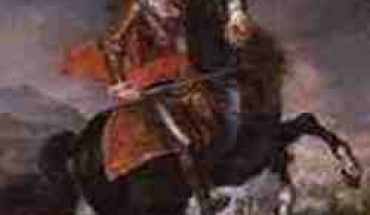Submitted by Owen McCafferty on Sun, 2009-07-05
So where did the flag come from?
This one’s a real tearjerker, so keep your hankies handy. And every single word is true.

Since this is a tale about fairies …
The story goes that many centuries ago the MacLeod chief of the time fell in love with a beautiful fairy princess, and she likewise with him.
However, when the princess asked the King of the Fairies, her father, for permission to marry the handsome and dashing Chief, he refused on the common-sense grounds that the Chief would only break her heart, because, as all know well, humans grow old and die whilst the “Shining Folk” live forever.
She wept in such bitter disappointment that the King, not being a complete killjoy, agreed that the two lovers might be married, but only for one year and one day, after which time she must return to the land of Fairie leaving behind everything from the human world.
The Chief and his new Lady MacLeod were totally enraptured with each other and it was therefore no surprise when 9 months on, a strapping and handsome son was born to the happy couple to great Clan rejoicing and celebration.
The dreaded day, of course, soon came when the beloved Lady MacLeod had to cash in her return ticket and head back to Fairy land. She had no choice. To break her promise would mean a terrible and wrathful curse descending on the people of Skye at the vengeful hands of the Fairy King and the Fairie Raide, a kind of fairy SS of the day, not to be messed with.

The Fairy Bridge
She left the broken-hearted Chief and her baby son, hugging both one final time, before running in tears from the castle to join her waiting father on the bridge now known as “The Fairy Bridge”, from where she disappeared forever.
Before she went, however, she made her husband promise that the child would never be left alone or be given cause to cry, for the sound of her own son’s cries would reach her even as far away as Fairy Land, and this she simply could not bear.
The Chief kept his promise, but his grief at the loss of the woman he loved was completely overwhelming and a deep depression lasting many months sank in over both him and the Clan.
The clan folk decided that something must be done to lift his spirits so, on his birthday, a great Ceilidh (party) was arranged with full finger buffet, free bar and disco ’til dawn.
The Chief had always been a keen dancer and, sure enough, the rousing sound of the bagpipes soon got him up and bopping and laughing for the first time since her Ladyship’s departure.
So great and so loud were the ensuing celebrations that the young nursemaid assigned to look after the infant Laird left his nursery in curious wonderment to watch the people in their finery and listen to the wonderful and uplifting music, from the top of the stairs.
She did not hear the wails of the waking bairn over all the noise from below. In her absence the child had kicked off his covers and was crying with the cold. His pitiful sobbing was soon heard by his mother in Fairy Land, however, just as she had predicted, and she appeared at once by his crib, taking him in her arms, comforting him and drying his tears whilst wrapping him in her silk shawl to warm the wee chap up again.
She whispered a few magic words in his ears, laid him back down, sang him a soothing song, kissed him on the forehead, and then was gone.
The nursemaid returned and stood by the door transfixed, listening to the hauntingly beautiful song that seemed to be coming from a room that was empty, apart from the now sleeping infant.
Upon seeing the strange square of silk, she took it and the baby straight to the Chief, showing him what she had found and recounting what she had heard.
Years later, when the boy grew up, he recalled his mother’s late night visit, telling his Father that the cloth, so she had told him, was a magic talisman to be kept safe and used only if ever the Clan MacLeod faced mortal danger. In that event it should be waved, flag-like, three times, whereupon the hosts of Fairie, the Knights of the Fairie Raide, would ride like some kind of Fairy Cavalry to the rescue.
As we’ve already established, there were to be three such blessings and no trivial stuff or else.
The Chief, accepting the son’s story without question, placed the “Fairy Flag” in a locked case and henceforth carried it with him wherever he went.
Since then, successive Chiefs of Clan MacLeod have acted as custodians of the Flag, and it is still kept at Dunvegan where it is now on display to the public, pending its final outing.
The song the fairy mother sang to her child and which was overheard by the nursemaid is still occasionally sung on Skye, and is known as the “Dunvegan Lullaby”.
OH GO ON, SPOIL IT NOW
Another, more plausible explanation for the origin of the flag is that it was brought back from the Holy Crusades at some point in MacLeod history and indeed, independent experts who have examined the cloth seem to support this theory, claiming that its fibre and design indicate that it was probably made in Syria sometime around the 11th century.
But hey, what do they know?

Rory Mor’s drinking horn
As an interesting footnote to the tale, and one which throws up another possible theory much favoured by FirstFoot, it is perhaps relevant that a great hollowed-out drinking horn, originating from the time of Malcolm (1296-1370) the 3rd chief of the Clan MacLeod, who slew a wild bull that had attacked him on his way home from some extramarital nookie one night and kept the horn (how apt) as a souvenir, is still used at Dunvegan and forms an integral part of the rite of passage of every new MacLeod chief.
The horn, holding over a litre of claret, must be drained in one single draft “without setting down or falling down”.
With such sense-numbing drinking exploits in mind, therefore, excessive even by Highland standards, it is little surprise to us that the MacLeods are away with the fairies.
It explains it all.
‹ Robert the Bruce up The Massacre of Glencoe ›




